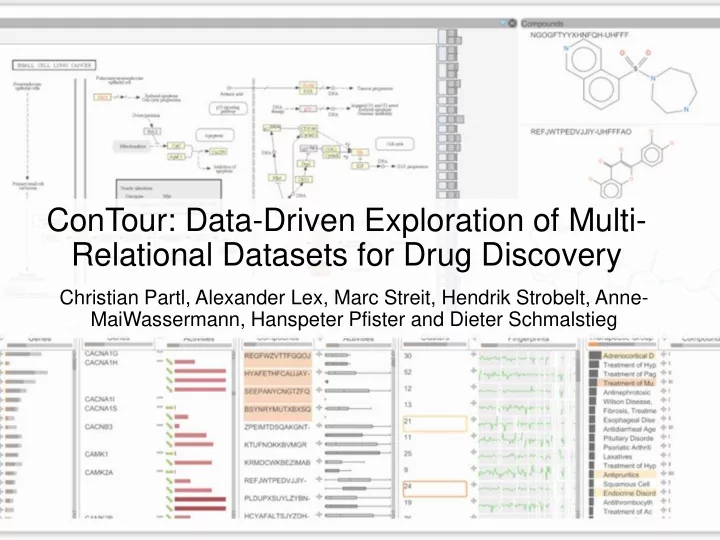

ConTour: Data-Driven Exploration of Multi- Relational Datasets for Drug Discovery Christian Partl, Alexander Lex, Marc Streit, Hendrik Strobelt, Anne- MaiWassermann, Hanspeter Pfister and Dieter Schmalstieg
Domain Problem = biological receptor = biological target UNDERSTANDING DRUG DISCOVERY Scenario 1: = chemical compound Targeted interaction, understood mechanism, desired outcome = potential target = direct target = inhibits target Result Interaction Compound (Phenotype)
Domain Problem = biological receptor = biological target UNDERSTANDING DRUG DISCOVERY Scenario 2: = chemical compound Indirect interaction, understood mechanism, desired outcome = potential target = direct target = inhibits target Result Interaction Compound (Phenotype)
Domain Problem = biological receptor = biological target UNDERSTANDING DRUG DISCOVERY Scenario 3: = chemical compound Complex interactions, mechanism poorly understood, multiple outcomes = potential target = direct target = inhibits target Result Interaction Compound (Phenotype)
Domain Problem Drug Discovery Main Goals • Identify a drug’s mechanism of action • Identify the biological process a drug modulates • Identify new drugs for specific therapeutic indications
ConTour History View Pathway View Compound View Relationship View Filter View
Data Abstraction derived* derived * Derived using a scheme propose by the Prous Integrity database
Data Abstraction “The drug discovery domain problem can be generalized to the problem of analysing multi-relational datasets […] Consequently, we argue that our approach is applicable to many other problems .”
Data Abstraction “The multi-relational data exploration problem can be interpreted as a graph exploration problem where each item of each dataset represents a node and the relationships between the items are the edges”
Task Analysis • T1 : Identify Related Items Item selection and highlighting Clicking, not hovering, on an item also moves all related items in columns to the top
Task Analysis • T1 : Identify Related Items Selection-based filters Filter choices when multiple items are selected
Task Analysis • T1 : Identify Related Items Nesting Simple Nesting
Task Analysis • T1 : Identify Related Items Nesting Recursive Nesting
Task Analysis • T2: Identify Items that Share a Relationships with a Set of Items Nesting Simple Nesting Recursive Nesting
Task Analysis • T3: Analyse Network Enrichment Enrichment Score Judging how specific two items are when compared to a third compounds Where : I = clusters K = compounds J = Pathways S(i,j) = pair score clusters pathways *I assume they take care of divide by 0?
Task Analysis • T4: Rank Items Sorting by interest Enrichment Score Sort alpha-numerically Sort by enrichment score compounds clusters pathways
Task Analysis • T4: Rank Items Sorting by interest Enrichment Score Sort alpha-numerically Sort by enrichment score compounds clusters pathways
Task Analysis • T5: Filter Items Depends on tasks 1 and 2 Navigation Local Filter : filter within a specific column Global Filter : remove items that are not connected to the source column
Task Analysis • T5: Filter Items Depends on tasks 1 and 2 Navigation Selection-based filters Nesting Simple Nesting Recursive Nesting
Task Analysis • T6 : View items in detail Pathway View Marks Individual Compound Compounds Clusters
Task Analysis • T6 : View items in detail Pathway View Channels Size Total # of compounds that interact with pathway Total # of compounds that interact with pathway Saturation Hue Compounds binding None Many One
Task Analysis • T6 : View items in detail Pathway View Linked Views Highlighting Hover
Task Analysis • T6 : View items in detail Compound View Hue : Elements
Implementation Details
source code: https://github.com/Caleydo/
ConTour Algorithm Design
ConTour History View Pathway View Compound View Relationship View Filter View
Relationship View • There are facets within the relationship view • Combination of tabular data and plots
Relationship View
Relationship View
Relationship View
Relationship View Approximately 100 numerical values shown here
Relationship View Compound:Gene binding Activating Inhibiting Binding Approximately 100 numerical values shown here
Relationship View T1 T2 T3 T4
T5 T5
Conclusions
System ConTour What : Data Multi-relational databases; node-link graph; clusters (derived) Why : Tasks Discovery; drill down; highlight relationships How : Multiple Relationship view; pathway view; Views compound view; history and filters Side-by-side linked views, containing How : Facet tabular data, bar plots, glyphs How : Selection Linked highlighting across facets; automatic sorting & Highlighting How : Filtering Drag and drop (nesting); user control (navigation) How : Ranking Enrichment score; highlight; user control (navigation) & sorting Simple marks with manipulation of hue and How : Encode saturation (pathway view) Dozens of columns; upper limit on HD display appears to Scale : about 20. Thousands of data items. Up to 8 simultaneous views for compounds; only 1 for pathways
Concluding Thoughts • Seems like a very good tool for use on structured datasets Case Studies • When there are indirect (inferred) relationships, it would be good to highlight this with some uncertainty • What about incomplete relationships?
Backup
Recommend
More recommend